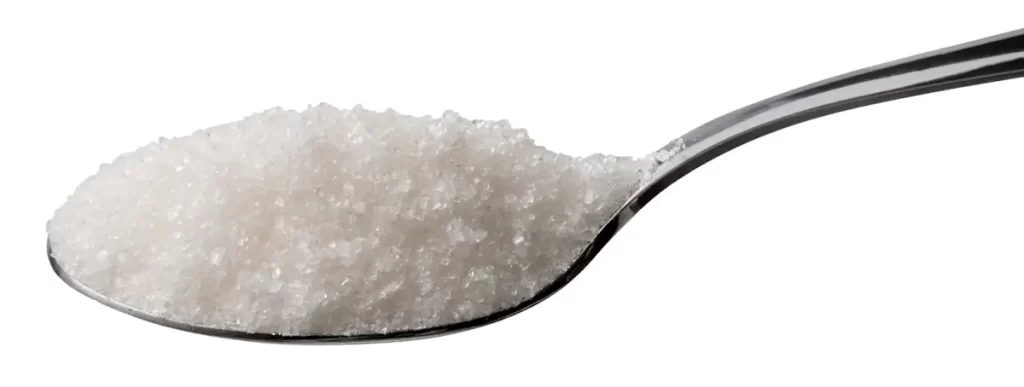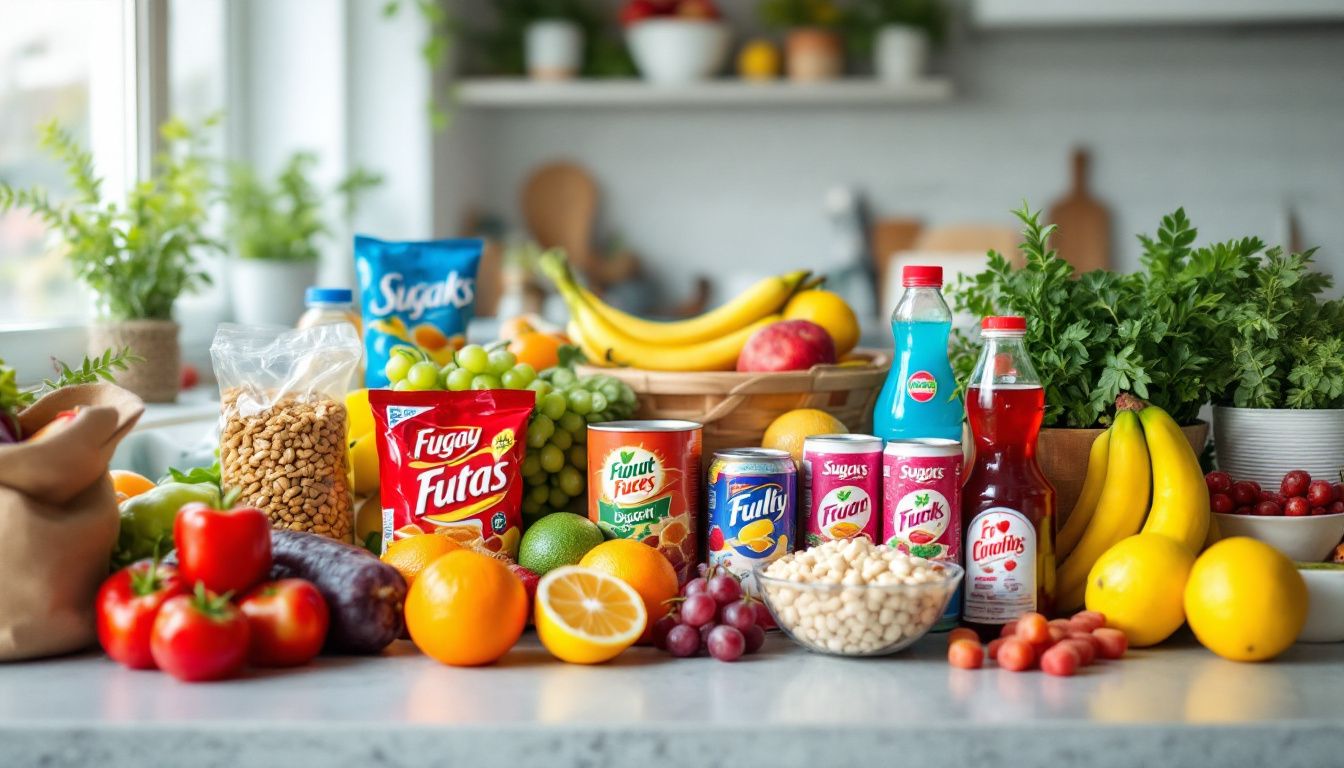Too much sugar can harm your health. It raises the risk of heart disease, type 2 diabetes, and obesity. This blog will explore how cutting added sugars can make a big difference. Keep reading to see how small changes could save lives!
Thank you for reading this post, don't forget to subscribe!Key Takeaways
- Cutting added sugars can prevent 2.5 million heart attacks, strokes, and cardiac arrests in the U.S., saving nearly 490,000 lives from cardiovascular diseases.
- Reducing sugar by 20% in packaged foods could prevent up to 750,000 cases of type 2 diabetes and save $4.28 billion in healthcare costs over ten years.
- High-sugar diets raise risks for obesity, type 2 diabetes, non-alcoholic fatty liver disease (NAFLD), and other chronic illnesses like heart disease.
- The National Salt and Sugar Reduction Initiative (NSSRI) focuses on reducing sugar in processed foods to improve public health while addressing disparities in underserved communities.
- Simple changes like choosing water over sugary drinks or reading food labels help lower added sugar intake for better long-term health outcomes.
The Impact of Excess Sugar on Health
Too much sugar can harm the body in many ways. It raises the risk of serious illnesses and can overwhelm important systems like blood glucose control.
Increased risk of heart disease
Eating a lot of added sugar can harm the heart. Diets high in sugar raise triglycerides and LDL cholesterol levels, which clog arteries and increase heart disease risk. These changes strain the heart over time, leading to bigger problems.
High sugar intake may also cause insulin resistance. This condition raises blood glucose levels and leads to type 2 diabetes—another key factor linked to cardiovascular diseases.
Cutting back on sugary drinks and processed foods helps protect your heart health long-term.
Contribution to obesity and diabetes
Too much added sugar leads to weight gain. Packaged foods and sugar-sweetened beverages are loaded with hidden sugars, raising calorie intake fast. Over time, this contributes to obesity.
High-fructose corn syrup, often found in processed foods, adds even more risks.
Excess sugar spikes blood glucose levels, causing insulin resistance—one of the main factors for type 2 diabetes. The National Salt and Sugar Reduction Initiative (NSSRI) could prevent around 750,000 diabetes cases over a lifetime.
Cutting back on free sugars helps control body fat and improve glycemic indices while lowering the chance of hyperglycemia or prediabetes.
Link to non-alcoholic fatty liver disease (NAFLD)
High sugar diets, especially those packed with fructose, can lead to non-alcoholic fatty liver disease (NAFLD). Fructose increases liver fat by promoting fat storage and triggering insulin resistance.
Over time, this can worsen into a more severe condition called nonalcoholic steatohepatitis (NASH).
Cutting back on added sugars in processed foods or sugar-sweetened beverages helps reduce the build-up of hepatic fat. This lowers the risk tied to metabolic syndrome factors like high triglycerides and pre-diabetes.
Simple steps like checking nutrition facts labels for hidden sugars make a big difference in protecting your liver health.
Nationwide Sugar Reduction Initiatives
Governments and health groups are working to cut sugar in foods and drinks. These changes aim to make everyday choices healthier for everyone.
Targeting packaged foods and beverages
Cutting sugar in packaged foods and drinks can save lives. Policies could reduce sugar by 20% in processed foods and 40% in sugary beverages. These changes aim to fight health issues like obesity, type 2 diabetes, and heart disease.
Lower-income groups are hit hardest by high-sugar diets—this shift could improve health equity.
Packaged snacks, sweets, and sugar-sweetened beverages make up a major part of daily calories for many people. Reforming these products is key to reducing sugar intake nationwide. With thoughtful guidelines, industries can market options with no added sugar while maintaining flavor that consumers enjoy.

Government policies and regulations
Policies targeting added sugars aim to reduce health risks. The National Salt and Sugar Reduction Initiative (NSSRI) is one example. It focuses on cutting sugar in packaged foods and beverages.
Over ten years, this policy could save the U.S. $4.28 billion in healthcare costs. For adults aged 35-79, lifetime savings may reach $118.04 billion.
These efforts are cost-effective within six years and fully cost-saving by nine years. Governments also enforce stricter food labeling rules to help consumers choose healthier options.
Such actions push industries toward reformulating ultra-processed foods with less sugar while protecting public health from chronic diseases like type 2 diabetes or cardiovascular complications.
Industry-led reformulations
Government regulations often push industries to make changes. Many companies now reformulate packaged foods and sugar-sweetened beverages to meet lower sugar targets. The National Salt and Sugar Reduction Initiative (NSSRI), finalized in February 2021, introduced voluntary goals for the food industry.
Past successes show this approach works. Cutting trans fats and reducing sodium in processed foods saved lives. Similar efforts for added sugars could improve health outcomes too—especially for lower-income communities.
These reforms may narrow gaps in chronic diseases like type 2 diabetes among Black and Hispanic adults, tackling key health disparities head-on.
Projected Health Benefits of Reducing Sugar
Cutting sugar can improve health in big ways—better heart function, steadier blood sugar levels, and a lower chance of serious illnesses. Keep reading to learn more!
Prevention of heart attacks and strokes
Reducing added sugars can save lives. Cutting sugar intake could prevent about 2.5 million heart attacks, strokes, and cardiac arrests in the U.S. This includes avoiding nearly 490,000 deaths from cardiovascular diseases like myocardial infarction or stroke.
Sugar-sweetened beverages and processed foods are major culprits behind cardiovascular disease (CVD). High sugar consumption increases blood sugar levels and leads to weight gain, raising heart risks.
Lowering sugar in diets improves glycemic control and reduces visceral fat—critical for better heart health.
Reduction in diabetes prevalence
Cutting added sugars can lower the cases of type 2 diabetes. The National Salt and Sugar Reduction Initiative (NSSRI) predicts that reducing sugar by 20% in packaged foods might prevent 750,000 diabetes cases over a lifetime.
Fewer people will face hyperglycemia, which harms blood vessels and nerves.
Lowering sugar means fewer sugary drinks like soda or energy drinks in diets. This change improves weight maintenance and reduces obesity—key triggers for diabetes. A healthier population faces less strain on Medicare and Medicaid systems.
Improved liver health also ties to better disease control for diabetics.
Now let’s explore how improved liver function links to reduced sugar intake…
Improved liver health
Too much sugar can harm your liver. It increases the risk of non-alcoholic fatty liver disease (NAFLD), which happens when fat builds up in the liver. Over 45% of Latinos face this issue, showing how widespread it is among certain groups.
Cutting added sugars by 20% could lower NAFLD rates and improve overall liver function.
Processed foods and sugary drinks are major culprits. Reducing these helps ease stress on the liver and prevents damage over time. Healthy habits like eating natural sugars from fruits or following dietary guidelines for Americans make a big difference in protecting your body.

Economic Benefits of Sugar Reduction
Cutting sugar helps save money on healthcare by preventing costly diseases. It also boosts work performance, leading to fewer sick days and better productivity.
Lower healthcare costs
Reducing added sugars can save billions in healthcare expenses. High sugar consumption leads to type 2 diabetes, heart disease, and other costly conditions. Implementing a nationwide policy could prevent about 2.5 million heart attacks, strokes, and cardiac arrests—saving both lives and money.
Less sugar in diets means fewer trips to the doctor. Treating chronic problems like hyperglycemia or cardiovascular diseases (CVD) drains resources. Lower rates of these illnesses free up funds for better diabetes care and public health programs while easing financial strain on families.
Increased productivity and reduced absenteeism
Cutting sugar can improve focus and energy. High sugar intake often leads to energy crashes, affecting work performance. Lowering sugar consumption helps maintain steady blood sugar levels, boosting productivity.
Excessive added sugars contribute to insulin resistance and type 2 diabetes. These health issues lead to more sick days at work. Healthier diets reduce absenteeism and support long-term workplace efficiency.
Addressing Health Disparities Through Sugar Reduction
Lower-income communities often face unequal access to healthy foods. Reducing added sugars can help close the gap in chronic health issues like obesity and type 2 diabetes.
Impact on underserved communities
Marginalized communities often face high rates of obesity and type 2 diabetes. Excessive sugar consumption worsens these health issues, leading to more severe chronic diseases. Processed foods and sugar-sweetened beverages are heavily marketed in these areas, making healthier choices harder to access.
Structural racism and inequitable access to healthy foods contribute to the problem. Families with lower income frequently rely on cheaper, calorie-dense options filled with added sugars.
Nationwide efforts to reduce sugar could help close gaps in obesity and diabetes outcomes for underserved populations.
Closing the gap in chronic disease outcomes
Reducing added sugars can help lower chronic disease rates, especially in underserved communities. These groups often face higher risks of type 2 diabetes and heart disease due to limited access to healthy foods.
Keeping sugar intake under 10% of daily calories aligns with dietary guidelines and supports better health.
Nationwide efforts like government policies or food industry changes could prevent nearly 750,000 diabetes cases and save thousands from cardiovascular deaths. Cutting excess sugar in processed foods benefits everyone but has the greatest impact on those who need it most.
Tips for Reducing Sugar Intake in Daily Life
Cutting added sugars can feel tricky, but small changes make a big difference. Simple swaps in meals and drinks help lower sugar without losing flavor.
Reading food labels carefully
Check the ingredient list on packaged foods. Ingredients appear in order of quantity, so added sugars near the top show high content. Look for words like “syrup,” “nectar,” or anything ending in “-ose” (like glucose).
These signal hidden sugars.
Compare different products using the “Total Sugars” and “Added Sugars” sections on labels. For example, a serving of sugar-sweetened beverages may contain 39 grams of added sugar—nearly your full daily limit under new health guidelines.
Reading closely helps reduce sugar intake while shopping smarter.
Replacing sugary beverages with healthier options
Many packaged drinks are filled with added sugars. These sugar-sweetened beverages (SSBs) increase the risk of obesity, type 2 diabetes, and high blood pressure. Replacing them can make a big difference in health.
Water is the best option—it has zero calories and no sugars. Unsweetened teas or sparkling water are good choices too.
Natural options like fresh fruit-infused water give flavor without extra calories. Low-fat milk or plant-based alternatives provide nutrients while keeping sugar levels low. Cutting just one soda a day could mean fewer than 150 kcal less consumed daily—helping with weight loss and reducing hyperglycemia risks over time.
Cooking at home to control added sugars
Home cooking helps you track added sugar better. Pre-packaged foods and processed meals often hide sugars in sauces, dressings, or marinades. By preparing food yourself, you pick ingredients with less sugar.
Using fresh produce like colorful fruits and vegetables can cut cravings for sugary snacks. Try swapping sugary desserts with fruit salads or smoothies made at home. This simple step lowers sugar consumption without sacrificing taste or variety in your meals.
The Role of Education and Awareness
Teaching people about the dangers of too much sugar can lead to smarter food choices. Schools, health campaigns, and community programs play a big role in spreading this knowledge.
Promoting public campaigns to reduce sugar
Public campaigns can help people cut back on sugar. Taxes on sugary drinks, paired with educational efforts, improve awareness of health risks like type 2 diabetes and heart disease.
The New York City Department of Health and Mental Hygiene has shown how such steps work. They launched ads highlighting the dangers of added sugars in sugar-sweetened beverages.
Policies that suggest healthier drink options also make a difference for kids and teens. Schools choosing low-sugar beverages as defaults teaches better habits early. These small shifts guide families toward choices that lower obesity rates and promote long-term health improvements nationwide.
Encouraging schools to adopt low-sugar policies
Limiting sugary snacks and drinks in schools helps kids build better eating habits. Swapping sugar-sweetened beverages for water or milk can lower overall sugar consumption. Offering fruits over candy teaches children to enjoy natural sugars instead of added sugars.
Healthier meals boost focus and energy, improving academic performance. Stable blood sugar levels sharpen concentration through the day. Schools play a big role in shaping dietary intervention, making low-sugar policies critical for future health.

Challenges in Implementing Nationwide Sugar Reductions
Changing how much sugar people eat is hard. Food companies push back, and many people like sweet foods too much to give them up easily.
Resistance from the food and beverage industry
The food and beverage industry often fights sugar-reducing policies. They resist measures like portion size limits and taxes on sugary drinks. Big companies claim such rules hurt consumer choice and business profits.
To sway opinions, they use intense marketing campaigns.
Brands promote “healthier” options that still have added sugars. Digital platforms target ads toward children, making sugary products seem appealing early on. This resistance delays efforts to lower sugar consumption in packaged foods and beverages.
Balancing consumer preferences and public health goals
Cutting sugar in processed foods can be tricky. Many people want healthier options, but they also love the taste of sugary products. Over 55% of shoppers now check labels for added sugars, showing a shift toward mindful eating habits.
Food companies face pressure to reduce sugars while keeping consumers happy. Reformulating recipes often involves using natural sweeteners or dietary fiber to maintain flavor and texture.
These changes aim to meet public health goals without losing brand loyalty or market share…
Next comes the role of diet changes like the Nordic Diet and their impact on stroke risk reduction!
How Diet Changes, Like the Nordic Diet, May Lower Stroke Risk
The Nordic diet focuses on whole grains, fatty fish, root vegetables, and berries. People who follow this diet may lower their stroke risk by 14% over ten years. This finding highlights the long-term benefits of better food choices.
Small changes in daily meals can make a big difference. Swapping processed foods for fresh ones or eating more natural sugars instead of added sugars could help improve health. A healthier heart and blood vessels reduce stroke chances—another reason to rethink your plate!
Reducing sugar fits perfectly with these kinds of dietary shifts…
Conclusion
Cutting sugar can change lives. It lowers risks of heart disease, diabetes, and liver problems. Nationwide efforts show we can improve health and cut healthcare costs. These changes benefit everyone—especially in underserved communities.
Small steps today mean big rewards tomorrow.
